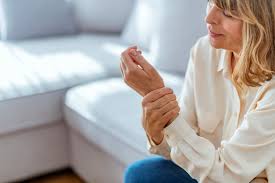Do I Have Arthritis? Early Signs Of Arthritis To Observe
March 28 2023 – Nysh Website

It’s normal to experience pain in your joints occasionally, especially if you’re into vigorous workout regimens or sports. Those pains are caused due to strained muscles and ligaments around the joints. But if you have been experiencing mild pain and stiffness daily, you might be wondering, “Do I have arthritis?” Rather than worrying about your symptoms, read this article to learn how to identify the early signs of arthritis.
What Is Arthritis?
In layman's terms, arthritis is defined as joint inflammation. It’s when one or more joints suffer a kind of inflammation that causes pain and worsens over time due to age. Unfortunately, there is no definite cure for arthritis, but medical science has improved over the years to treat this ailment.
However, arthritis cannot be streamlined into one single disease. There are different types of arthritis and knowing which one you may have at the earliest will help in treating it better.
Symptoms Of Osteoarthritis
Osteoarthritis is the most common form of arthritis that affects millions of people. Getting into a more technical side, the cartilage acts as a shock absorber between two bones. When the cartilage that protects your bone fails to function properly, the early signs of arthritis begin to rear up, also known as osteoarthritis.
Your cartilage wears down due to age since the lubrication fluid inside your joints becomes less. This also affects flexibility and causes stiffness in joints, making everyday tasks such as opening bottles or walking difficult. Typically, osteoarthritis is regarded as a wear-and-tear disease. Apart from affecting the cartilage, it harms the connective tissues that help the joints to stay connected with each other.
The common areas it affects the most are the joints in your hands, knees, hips, and spine. Some of the early signs of osteoarthritis are:
- Pain at the joints, especially during or after movement.
- Stiffness at joints, especially when you wake up or if you’ve been sitting too long.
- Tenderness of joints.
- Decreased range of motion and reduced flexibility.
- Swelling around joints.
- Presence of painless, extra lumps of bone, also known as bone spurs.
Symptoms Of Rheumatoid Arthritis
Rheumatoid arthritis (RA) is an autoimmune disorder, meaning the immune system turns against the body instead of protecting it from disease. The symptoms go beyond joint pains as this chronic inflammatory disorder can even harm your skin, bone marrow, lungs, heart, and blood vessels.
One point of difference between osteoarthritis and rheumatoid arthritis is that the latter affects the lining of the joints, causing them to swell and leading to bone deformity in the end.
The most common complaint of people with rheumatoid arthritis is dryness in the eyes. This is one of the early signs of arthritis you should observe. Dry eyes aren't much of a concern but for people with an autoimmune disorder like RA, dry eyes are painful and chronic. In some extreme cases, severe dry eyes can cause the cornea to scar due to the infection present.
Other symptoms of RA include:
- Fever
- Sweating
- Loss of appetite
- Shortness of breath (scarring within the lungs)
- Fatigue
Symptoms Of Psoriatic Arthritis
This type of arthritis affects those who have the skin condition of psoriasis. With psoriasis, your skin develops scaly patches or rashes that spread throughout your hands, feet, ankles, and knees. Like RA, psoriatic arthritis (PsA) is an autoimmune disease and that's why it’s important to notice its symptoms at the earliest.
Both diseases, psoriasis and psoriatic arthritis, are chronic ailments that worsen over time, with varying degrees of remission. At times, the symptoms may go away temporarily, but you shouldn’t stop the medication when that happens.
Symptoms of psoriatic arthritis came with joint pain, stiffness, and swelling. However, these are some other symptoms you should watch out for:
- Psoriatic arthritis mainly targets your fingertips and toes, causing them to swell.
- You’ll also feel your feet aching, mainly your Achilles tendinitis (the back portion of your heel) or your plantar fasciitis (the sole of your foot).
- Those with PsA also develop a lower back condition called spondylitis.
- You might notice changes in your nails, making it an early sign of arthritis to observe. You’ll find your nails deforming and even separating from the nail bed.
Signs Of Gout
Gout is a different form of arthritis that causes intense pain, swelling, and tenderness in multiple joints, specifically the big toe. A gout attack can happen suddenly in the middle of the night; it’ll feel as if your big toe is on fire. At times, the affected joint is so sensitive that even a light touch would intensify the pain.
Gout is usually caused when there’s an excess buildup of uric acid in your body - a condition called hyperuricemia. When there’s an increase in uric acid, uric acid crystals get trapped in your joints and tissues, causing the condition.
These are the symptoms you should look out for if you think you have gout:
- Intense joint pain is usually in the big toe but can affect other parts as well such as your knees, ankles, elbows, wrists, and fingers. The pain is most severe in the initial 4 to 12 hours after it occurs.
- Your joints will have a limited range of motion.
- After the pain lessens, you’ll still find some lingering discomfort in your joints for a few weeks. If there’s remission, the attack will target more joints in some cases.
Summing Up
Having arthritis is painful and incurable, but there’s always hope. If you notice the early signs of arthritis, proper treatment can be administered and you’ll have fewer remissions. Always remember to consult your doctor if you have been experiencing joint pain for a long time. Don’t be your own doctor!
FAQs
At What Age Does Arthritis Usually Start?
Arthritis symptoms typically appear in people between the ages of 40 and 60. Some of the early signs of arthritis to observe are joint pain, stiffness, and decreased range of motion.
Does Arthritis Go Away With Exercise?
Arthritis is incurable, but exercise can help in reducing some of its symptoms such as joint pain and muscle stiffness.
What Is The Most Painful Type Of Arthritis?
Rheumatoid arthritis can be considered the most painful type of arthritis since it not only targets the joints but also surrounding organs as well.


0 comments